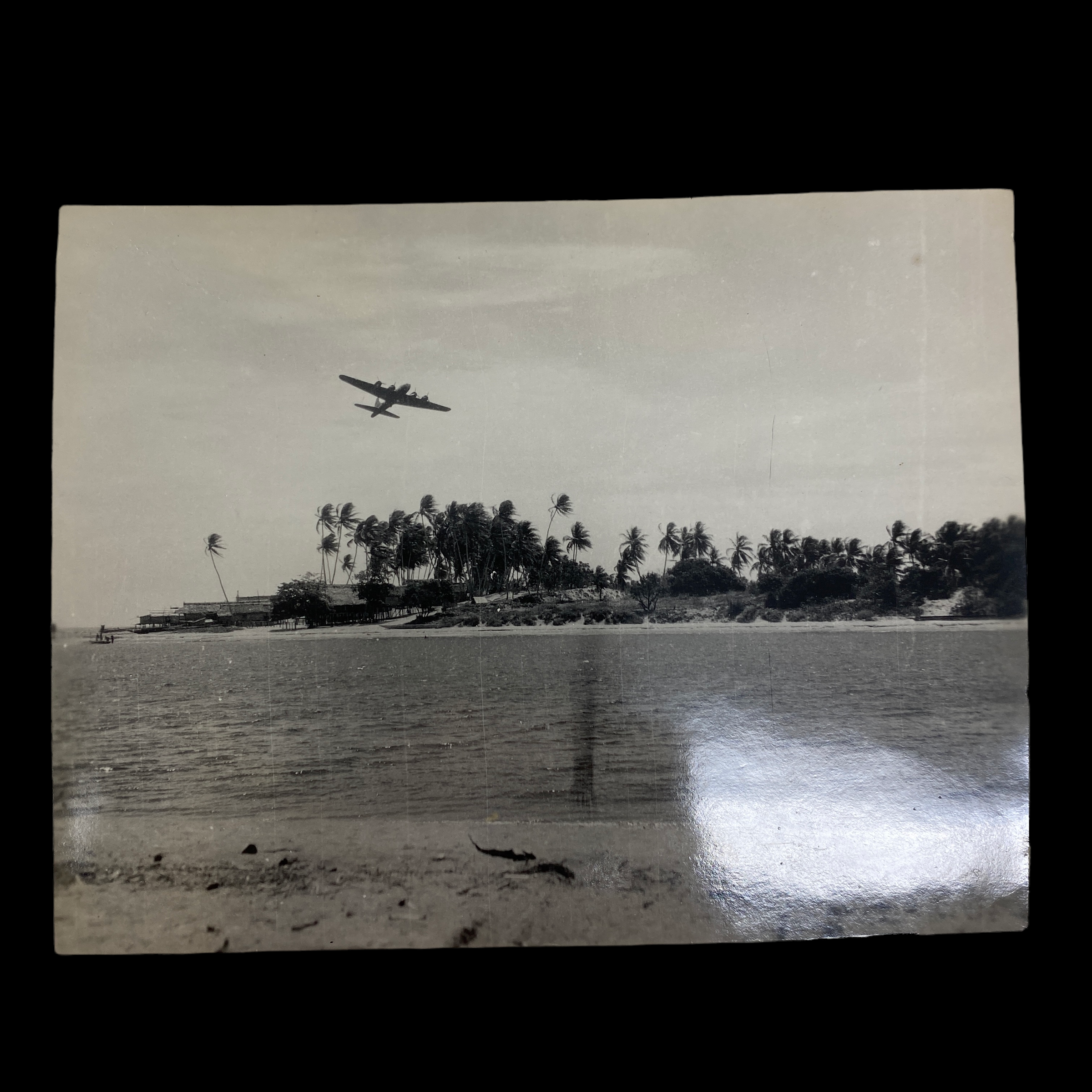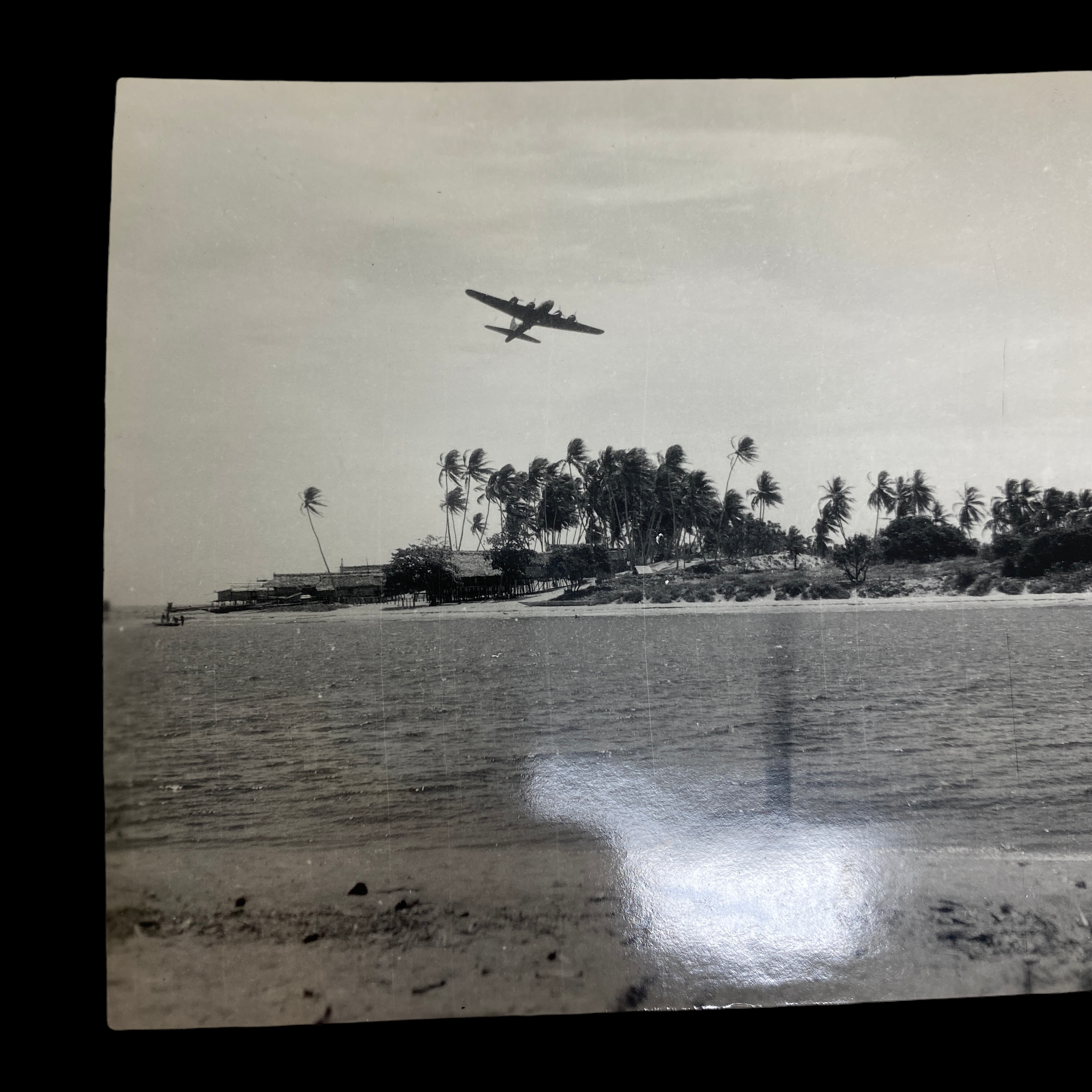WWII B-17 in Pacific Theater Original Soldier Taken Photograph





WWII B-17 in Pacific Theater Original Soldier Taken Photograph
Comes with C.O.A.
This original World War II photograph was personally taken from a soldier on the ground as an American B-17 appears to be taking off or coming in for landing.
The B-17 Flying Fortress first saw combat in American colours in the Pacific, on the first day of the Japanese onslaught, when nearly 30 aircraft were destroyed on the ground. Despite this inauspicious start to the war, the B-17 went on to perform important duties in the Pacific in the first two years of the war.The B-17D was the first version of the aircraft seen to be fully combat ready, and three quarters of the aircraft produced were sent to the Pacific. The first twenty one aircraft were sent to Hickman Field, Hawaii, leaving Hamilton Field, California, on 21 May 1941. This was the first time a large group of bombers had flown so far over the ocean, but the aircraft arrived intact, within five minutes of their estimated arrival time. They were allocated to the 5th Bombardment Group. In September nine aircraft were transferred to the 19th Bombardment Group on the Philippines, where they were joined by another 26 aircraft in November 1941. Finally, on 6 December 1941 six B-17Ds of the 7th Bombardment Group took off from the United States on the first stage of their journey to the Philippines. Their next stop would be at Pearl Harbor.
Five bombardment groups used the B-17 in the Pacific. Of those two (5th and 11th) began the war with the Hawaiian Air Force., which soon became the 7th Air Force. They were then transferred to the 13th Air Force and took part in the campaign in the South Pacific, fighting in the Solomon Islands. The 7th and 19th Bombardment Groups were either in the Philippines or on their way in December 1941. They took part in the Allied retreat through the south west Pacific, ending up in Australia, where they were joined by the 43rd Bombardment Group. The 19th and 43rd groups remained in the south west Pacific with the 5th Air Force, while the 5th Bombardment Group was sent to India to join the 10th Air Force in May 1942.
5th Air Force:
The small number of B-17s remaining on the Philippines began a series of desperate sorties against the invading Japanese on 10 December. This first mission saw Captain Colin Kelly win a posthumous Distinguished Service Cross for an attack that at the time was believed to have sunk a Japanese battleship (although actually achieved near misses against the Japanese cruiser Ashigara. After a week of costly operations, the surviving aircraft of the 19th Bombardment Group were withdrawn to Batchelor Field, Australia. From there they conducted a shuttle mission, attacking Japanese targets and then flying on to Del Monte airfield, before returning to Australia on 24 December.By the end of December the surviving aircraft of the 19th BG moved back north to Java. On 14 January they were joined there by the 7th BG. Both units would remain on Java until March 1942, taking part in the brave but ultimately futile attempts to defend the Philippines and the Dutch East Indies. The B-17s were never present in large enough numbers to make any real difference to the course of the campaign. The 7th BG was then transferred to India, while the 19th BG returned to Australia. There they were joined by the 43rd Bombardment Group. The two units took part in the campaign on Papua New Guinea, before the 19th BG was moved back to America at the end of 1942. The 43rd BG kept its B-17s into 1943 when they were replaced by B-24s.
7th and 13th Air Force:
The first few months of 1942 had been quiet for the two 7th Air Force B-17 groups based on Hawaii, but at the end of May sixteen B-17s from the 5th and 11th Bombardment Groups were sent to Midway. Nine B-17s from Midway fired the first shots of the battle of Midway, attacking five large Japanese ships 570 miles from Midway. The B-17 crews claimed five direct hits, but research after the war suggests that they only scored one near miss. During the battle the B-17s based on Midway flew 55 sorties in 16 separate attacks, but probably without actually scoring any direct hits on Japanese hits. Combat experience during the Second World War proved that the level bomber was not a very good anti-shipping weapon. It was far too easy for the enemy ship to take evasive action. Defenders of the B-17 as an anti-shipping weapon point out that there were never enough B-17s involved in these naval battles. Official doctrine suggested that 20 B-17s would be needed to guarantee that 7% of bombs would hit their targets. In this case at least those opponents of the B-17 who would have preferred to have had a larger number of smaller aircraft were right – the dive bomber and the torpedo bomber were much more effective anti-shipping weapons. A more valid defence of the B-17 was that it forced the Japanese carriers into evasive manoeuvres that greatly reduced their efficiency, increasing the amount of time it took to launch or recover aircraft.Both the 5th and 11th Bombardment Groups joined the 13th Air Force during 1942 and took part in the American campaign in the south west Pacific, fighting during the campaigns in the Solomon Islands (including the battle for Guadalcanal) and the return to the Philippines. By the middle of 1943 both units had replaced their B-17s with B-24 Liberators.
10th Air Force:
In May 1942 the 7th Bombardment Group was transferred from the 5th Air Force to form part of the 10th Air Force in India. It continued to operate its B-17s for most of the rest of the year, operating against the Japanese in Burma.